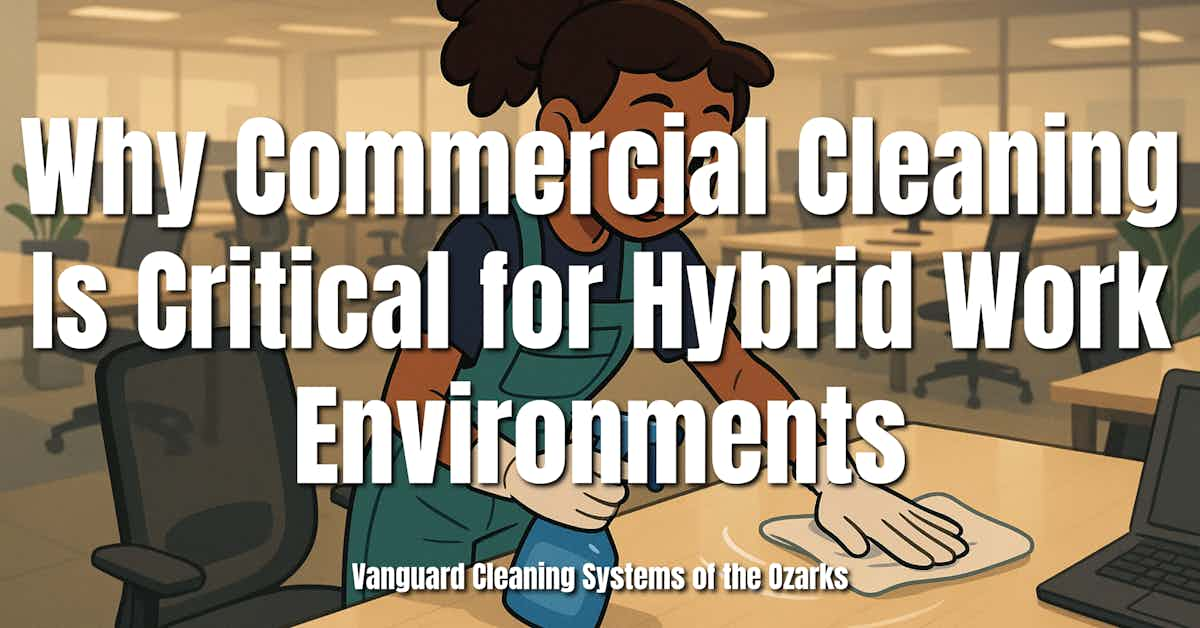In hybrid workplaces, cleaning isn't just maintenance—it's the front line of health, trust, and operational success.

The Role of Commercial Cleaning in Hybrid Workplaces
Hybrid work changed more than just schedules—it redefined how we think about cleanliness, safety, and shared responsibility in the workplace. With employees cycling between home and office, maintaining hygienic environments has become a daily challenge that affects health, trust, and productivity.
Unlike traditional office settings, hybrid workplaces require a dynamic cleaning approach that adapts to fluctuating occupancy, shared surfaces, and unpredictable usage patterns. From disinfecting high-touch areas to supporting cleaning staff through automation and ergonomics, commercial cleaning is no longer a background function—it’s a frontline strategy for business continuity in the modern era.
Commercial Cleaning Safeguards Health in Shared-Use Spaces
Hybrid work environments bring people in and out of the office on alternating schedules, which means shared surfaces see more turnover—and more germs.
Key health risks emerge from:
- Shared desks, chairs, and computer equipment
- Communal areas like kitchens, restrooms, and conference rooms
- High-touch surfaces such as door handles, elevator buttons, and railings
Routine commercial cleaning reduces bacterial and viral load in these zones, limiting the spread of illness between rotating staff.
Clean, well-maintained spaces also send a clear message:
- Employees are valued.
- Health is a priority.
- It’s safe to come back to the office.
When staff trust the environment, they're more likely to re-engage with in-person work—and that boosts morale, collaboration, and performance.
Cleaning Staff Face Increased Workload Under Hybrid Schedules
Hybrid work may reduce the number of people in the office at any one time, but it increases the complexity of cleaning. Staggered schedules mean cleaners often have to sanitize more frequently, with less predictability.
Common workload challenges include:
- Frequent turnover of shared spaces requiring multiple cleanings per day
- Compressed cleaning windows between employee shifts or hybrid team rotations
- Event-driven spikes, such as all-hands meetings or in-office team days, which require deeper, faster cleaning efforts
These factors result in:
- More detailed tasks in less time
- Higher physical demands on cleaning crews
- Increased mental strain from balancing expectations and tight timelines
Without additional staffing or updated workflows, janitorial teams risk burnout—making strategic scheduling and realistic task distribution essential for maintaining quality and safety.
Worker Safety Is Often Overlooked in Commercial Cleaning
While cleanliness is in the spotlight, the well-being of the workers behind it often isn’t. Commercial cleaners face high physical demands, and in many hybrid workplaces, their safety needs remain unaddressed.
Key concerns include:
- Repetitive strain injuries from constant bending, lifting, and scrubbing
- Awkward postures caused by hard-to-reach surfaces and fast-paced routines
- Limited access to ergonomic tools or adjustable equipment
- Inadequate safety training, especially for outsourced or part-time staff
In hybrid environments, fluctuating occupancy can lead to inconsistent cleaning loads—making it harder for staff to pace themselves or anticipate demands.
Addressing worker safety means:
- Providing proper training and protective gear
- Using ergonomic equipment that reduces strain
- Acknowledging cleaning as skilled, essential work
Cleaner health directly impacts cleaning quality. Prioritizing their safety isn’t optional—it’s foundational.
Automation and Smart Cleaning Technologies Are Gaining Traction
As hybrid offices increase complexity, automation is helping commercial cleaning teams keep up with demand. Smart technologies are reshaping how spaces are sanitized—making cleaning faster, more targeted, and less physically taxing.
Key advancements include:
- Robotic floor cleaners that handle large areas during off-hours
- AI-driven task allocation based on real-time occupancy data
- Sensor-based systems that alert teams when areas need attention
- Cloud dashboards to track cleaning schedules and verify completion
These tools:
- Reduce repetitive strain for human workers
- Free up time for detail-focused tasks like touchpoint disinfection
- Improve accountability through data and performance tracking
Smart cleaning isn’t about replacing workers—it’s about supporting them. Automation allows janitorial teams to work more efficiently, reduce injury risks, and maintain high standards even as demands shift day by day.
Advanced Surface Treatments Improve Hygiene Between Cleanings
In hybrid offices, cleaning crews can’t be everywhere at once. That’s where advanced surface technologies step in—offering continuous protection in high-touch areas between scheduled cleanings.
Examples of these innovations include:
- Self-cleaning materials that resist microbial buildup
- Antiviral surface coatings that neutralize pathogens on contact
- Oxygen-plasma cleaning for precision disinfection in sensitive equipment areas
- Antifouling membranes used in filtration systems to prevent contamination
These technologies work best when paired with regular cleaning routines. They:
- Extend surface hygiene beyond manual disinfection windows
- Reduce microbial load in high-traffic, shared environments
- Support health protocols in places with rotating staff and unpredictable usage
For hybrid workspaces, where timing and access vary, these passive solutions help close the gap—keeping shared surfaces safer, longer.
Commercial Cleaning Supports Continuity and Operations
A clean workplace isn't just a perk—it’s a critical part of running a reliable, productive business in the hybrid era. When cleanliness is consistent, everything else runs smoother.
Here’s how:
- Reduces sick days by minimizing exposure to viruses and bacteria
- Boosts employee trust in the safety of returning to shared spaces
- Improves customer and client perception of the business environment
- Ensures compliance with evolving health and safety standards
Cleanliness also enhances:
- Collaboration—employees are more willing to gather in person
- Focus and morale—clutter and dirt increase stress and distraction
- Operational uptime—less illness means fewer disruptions
In a hybrid setting, where unpredictability is the norm, consistent commercial cleaning provides the stability that keeps teams, schedules, and services running without unnecessary setbacks.
Investing in Cleaning Is Investing in People
At its core, commercial cleaning is about protecting the people who occupy a space—employees, clients, visitors, and the cleaning staff themselves. In hybrid environments, that protection must adapt to shifting needs and higher expectations.
Key benefits of treating cleaning as a people-first investment:
- Healthier teams mean fewer absences and stronger performance
- Cleaner environments foster respect, trust, and workplace pride
- Valued cleaners perform better and stay longer when given proper tools and support
- Transparent protocols give everyone peace of mind in shared settings
When businesses prioritize cleaning as part of their culture—not just compliance—they send a clear message:
You matter. Your health matters. This space was made safe for you.
That message builds stronger teams, stronger retention, and a more resilient workplace overall.
Why Commercial Cleaning Matters in Hybrid Workplaces
What makes hybrid workplaces more challenging to clean?
Fluctuating occupancy, shared desks, and unpredictable usage patterns require more frequent and flexible cleaning routines.
How does commercial cleaning reduce illness?
Regular disinfection of high-touch surfaces limits the spread of viruses and bacteria, lowering the risk of workplace transmission.
Why is cleaner safety important in hybrid environments?
Compressed schedules and increased expectations lead to physical strain—making ergonomic tools and training essential for worker health.
Can automation replace cleaning staff?
No. Automation supports teams by handling repetitive tasks, but human oversight and detail-focused work remain critical.
What technologies improve cleaning outcomes between shifts?
Self-cleaning coatings, antimicrobial surfaces, and oxygen-plasma treatments help maintain hygiene between manual cleanings.
How does visible cleaning impact employee confidence?
Seeing regular, professional cleaning reassures employees that their health is a priority—boosting trust and morale.
Is commercial cleaning a compliance issue or a business strategy?
Both. It ensures health standards are met while directly supporting productivity, retention, and operational stability.
References
- Lee, W., Lin, J., Howard, N., & Bao, S. (2021). Measuring risks for commercial cleaner safety: A scoping review. Proceedings of the Human Factors and Ergonomics Society Annual Meeting, 65, 1598 - 1599. https://doi.org/10.1177/1071181321651088
- Lee, W., Lin, J., Howard, N., & Bao, S. (2022). Methods for measuring physical workload among commercial cleaners: A scoping review. International Journal of Industrial Ergonomics. https://doi.org/10.1016/j.ergon.2022.103319
- Bao, S., Walker, B., Milek, D., Lee, W., Ryan, A., Lin, J., Goggins, R., & Rivera, C. (2020). Workload Issues among Commercial Cleaning Workers (Discussion Panel). Proceedings of the Human Factors and Ergonomics Society Annual Meeting, 64, 947 - 949. https://doi.org/10.1177/1071181320641226
- Yun, Y., Hou, L., Feng, Z., Jin, W., Liu, Y., Wang, H., He, R., Guo, W., Han, B., Qin, B., & Li, J. (2022). A Deep-Learning-based System for Indoor Active Cleaning. 2022 IEEE/RSJ International Conference on Intelligent Robots and Systems (IROS), 7803-7808. https://doi.org/10.1109/IROS47612.2022.9982137
- Wang, Y., Hong, X., , Z., , T., Qin, B., & Su, Z. (2023). Towards Practical Multi-Robot Hybrid Tasks Allocation for Autonomous Cleaning. ArXiv, abs/2303.06531. https://doi.org/10.48550/arXiv.2303.06531
- Brunner, R. (1992). Oxygen-plasma cleaning of hybrid integrated circuits. AT&T Technical Journal, 71, 52-58. https://doi.org/10.1002/J.1538-7305.1992.TB00158.X
- Geng, Z., Wang, X., Jiang, H., Zhang, L., Chen, Z., Feng, Y., Geng, W., Yang, X., Huo, M., & Sun, J. (2019). High-Performance TiO2 Nanotubes/Poly(aryl ether sulfone) Hybrid Self-Cleaning Anti-Fouling Ultrafiltration Membranes. Polymers, https://doi.org/10.3390/polym11030555
Conclusion: Cleaning Is the Backbone of a Healthy Hybrid Workplace
As hybrid work continues to evolve, so must the strategies that keep workspaces safe, functional, and welcoming. Commercial cleaning now plays a pivotal role in business operations—no longer just a background service, but a daily safeguard for health and productivity.
To meet the demands of flexible schedules and shared spaces, organizations must:
- Prioritize cleaner safety and training
- Invest in automation and surface technologies
- Maintain consistent, visible cleaning routines
- Treat cleaning as part of their people-first strategy
When these elements come together, cleaning becomes more than maintenance—it becomes a competitive advantage in the modern workplace.
Vanguard Cleaning Systems of the Ozarks' franchise-owned custodial service provider business cleans more than 8M sq. ft. weekly, maintaining an industry-topping 95+% of its customer base, year-over-year, and boasting more than 60 5-star Google reviews.
Need more capability from your vendor partners? --Let's talk.
In Oklahoma, dial 918-960-4450
In Arkansas, dial 479-717-2410
In Missouri, dial 417-812-9777

